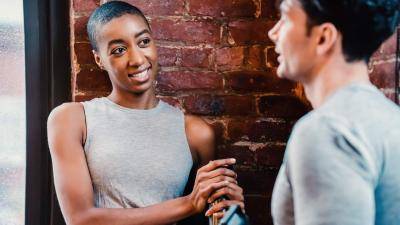Although COVID-19 has put a pause on large cattle call auditions for agents, companies, and shows, that doesn’t mean projects and agencies have stopped castings altogether. (Just recently I saw an agency calling for people to audition via Instagram story!) Since casting directors can’t see you in person right now, your dance reel needs to be in ready-to-watch condition. However, not all artists are skilled in video editing or cinematography, so how are we supposed to know what to include in a reel? Are there certain types of video footage we need to have? Should we leave certain clips out? What kind of music should we use in the background?
Before we answer any of these questions, let’s get some basics out of the way.
The purpose of a dance reel is to highlight a dancer’s skills in a short, accessible, and shareable video format. Usually one to two minutes in length (or even shorter), reels are especially crucial for dancers to have for dance castings today. “[With] the advancement of technology there is no reason a performer should not have something digitally available to promote themselves,” said Julianna Lichtman Galanek, Clear Talent Group’s Director of Commercial Dance and Young People. “When I receive a submission I expect footage to be included to review. If a submission does not include footage, [I’ll] likely...move onto the next submission.”
Galanek also noted that one of the biggest issues she sees when dancers submit reels or clips is poor video footage quality. Even though you can get great shots on your smartphone, it’s not going to work in your favor if the lighting is bad, the footage is grainy, or if you aren’t clearly seen in the frame.
Spending time on improving your reel now is going to help your career in the long run
If you know your reel isn’t up to par, you might be thinking about shooting your own stuff (and if you haven’t been working during the shutdown, you likely have time to do so). However, you might not know where to start or what kind of styles you should be including. Galanek says that while including anything from your professional jobs is great, including footage of yourself actually dancing in the styles you’re competitive in is crucial for a dance casting. “Ideally, I like to see a full combination, instead of a lot of cuts jumping from style to style,” she said. “Seeing footage of a full 30-second jazz combination, then a full 45-second hip hop combination helps me better get to know you...The better I know my clients, the better I can advocate and promote them!” When in doubt, shorter clips (less than 20 - 30 seconds) filled with as much footage of your best moves is always the way to go.
Glyn Gray, co-founder of DancePlug and co-director of StirStudios (an LA-based creative production house), says there are benefits to even filming an entirely new reel from the ground up. “It will look better, it will be consistent and completely up-to-date, [as opposed to relying on] footage from 10 years ago,” he noted.
If you are looking into filming new clips, there are a few things you should know. Gray, who is also a professional video editor, recommends capturing all wide shots on a tripod first so you have a solid safety net. Once you have these, then you can play around with interesting angles. It also might be difficult to film inside a studio right now, as many still aren’t consistently open, even for private rental use. So, if you choose to film outside (which is free), take into consideration what time of day you plan on shooting. “Natural light can be awesome--and a pain,” stressed Gray. “Early morning or [late] afternoon are the best times as the sun is not overhead.” He also recommends finding an interesting backdrop to shoot in front of, such as a brick or solid-colored wall. If possible, try to have someone you trust come with you as you’re shooting. This person can act as an objective eye and give you tips throughout the shoot while you focus on your performance. Having a friend or assistant can also be helpful for framing shots of the full body. But remember to adhere to social distancing guidelines and wear a mask when not performing, especially if you haven’t been quarantining with them!
So now you have your footage. But what about the editing? If you aren’t comfortable with editing the footage yourself, there’s no shame in hiring a video editor to help put your reel together. “The biggest thing here is an outside eye,” Gray mentioned. “You, as an artist, [pour] so much work into what you are doing [that] you can easily get emotional about all the footage. Having an editor with a keen eye [for dance] can help bring together some amazing things.”
Even if you do decide to pass your footage off to an editor, there are a few technical things you should be aware of to make this process go a lot smoother.
The first thing you should do is make sure that all of your clips are in the highest quality possible, even if they’re all on an iPhone, and try your best not to just send over Youtube URLs. To make your editor’s job easier, Gray suggests organizing all of your footage into different folders as well as creating a list of particular shots (also known as a “shot list”) or any video editing notes you want to see included in the final product. “[This] gives the editor a great start to the project,” said Gray. It’s also important that you know exactly where this reel is going to end up and what purpose the reel is going to serve. Are you uploading it on your website so studios can see how great of a teacher you are? Are you going to post it on Instagram so agents can see your work? Are you submitting it to various directors in a bid to choreograph a music video? Communicate this to an editor! They can help format your final edit into various file sizes and lengths to accommodate different platforms and purposes.
“[With] the advancement of technology there is no reason a performer should not have something digitally available to promote themselves,” - Julianna Lichtman Galanek, Clear Talent Group
One final element you have to think about is adding music. “As much as commercial songs have a particular vibe [to them], if you do not have the rights, it will get pulled down,” said Gray. Instagram and YouTube remove class videos all the time because they violate music rights, so when it comes to choosing music for your reel, finding royalty-free music is going to be your best option. There are a handful of sites where you can download various tracks, including Purple Planet, Bensound, Free Music Archive, to name a few. Gray recommends selecting an upbeat track to go with your dance reel. “The attention span for viewers is so short [and you] have to get to the point really fast,” noted Gray. “With that said, selecting a slow song is probably not a great option as you want to include as much diversity as possible.”
Ultimately, spending time on improving your reel now is going to help your career in the long run, even after the COVID-19 crisis dies down. You don’t have to be an expert in video editing to put together a high-quality dance reel that shows off your work; you just need to be prepared. “[Dance reels] are definitely an asset in getting booked [right now],” stressed Galanek. “[In-person] auditions are not yet happening, but direct bookings are DEFINITELY happening. Choreographers and casting directors are asking to see Instagram accounts...as well as reels...The sooner you can have these materials ready to go, the more prepared you'll be when they are asked of you.”




